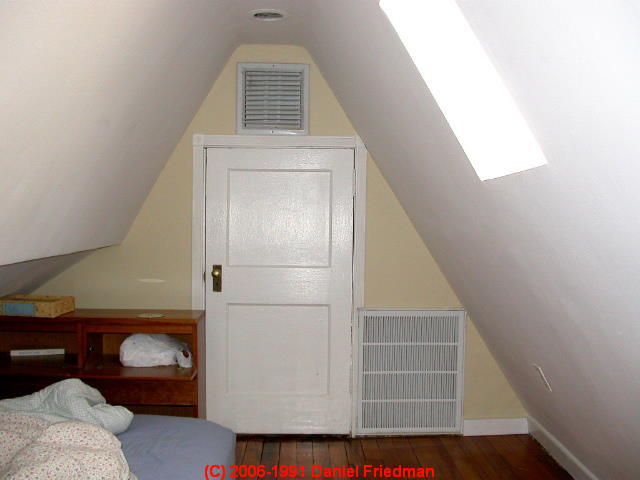 Air Register Location
Air Register Location
Proper Placement of Heating or Cooling Registers & Ducts
- POST a QUESTION or COMMENT about the proper location for heating or cooling air registers
HVAC heating & cooling air supply & return register locations:
Air Conditioning (or Heating) Duct supply or return air register placement mistakes can increase cooling or heating costs, limit system capacity, and can even be unsafe.
This article describes the proper location and placement of air supply and air return registers in HVAC systems and addresses problems such as misplaced or missing air conditioning cool air supply or return air registers, improper cooling duct routing, cooling (or heating) air duct corrosion, and defective heating or cooling duct work.
Page top photo: a not so great air supply (over the door) and air return (at the floor next to the door) register location.InspectAPedia tolerates no conflicts of interest. We have no relationship with advertisers, products, or services discussed at this website.
- Daniel Friedman, Publisher/Editor/Author - See WHO ARE WE?
Location of air conditioning & heating return & supply registers
Supply and return too close together result in short-circuiting
You don't have to be an HVAC design engineer to see that in the photograph at page top and shown again here the air conditioning supply register is above and just a few feet from the central air conditioning return grille.
Cool air delivered to this attic room from the supply register over the door will mostly fall down to be simply drawn right back into the return.
Ventilation and HVAC experts call this air movement short-circuiting: the air being supplied is taking a shortcut right back into the return duct rather than mixing with air in the cooled or heated space.
Short-circuiting of ventilation air occurs when ventilation air enters and leaves a space or duct before it has a chance to mix well enough with the room air to do the job it was intended to do - that is, to adequately dilute pollutants, or to break up stratified air in the occupied space. Occupants are left too cold or too hot or they are left complaining about poor indoor air quality. - adapted from Prozuments(2017).
Poor supply and return duct locations like this can severely reduce the effectiveness of the cooling system and increase its operating costs.
In this particular home the installer was confronted with a shoehorn retrofit of the air handler and duct work into a sub-standard attic bedroom closet in an area where s/he was not permitted to open cathedral ceilings nor to construct a delivery duct along the ceiling or under the floors.
It was a costly to operate and poor performing air conditioning installation.
Location of Heating or Cooling Return Registers in Basements
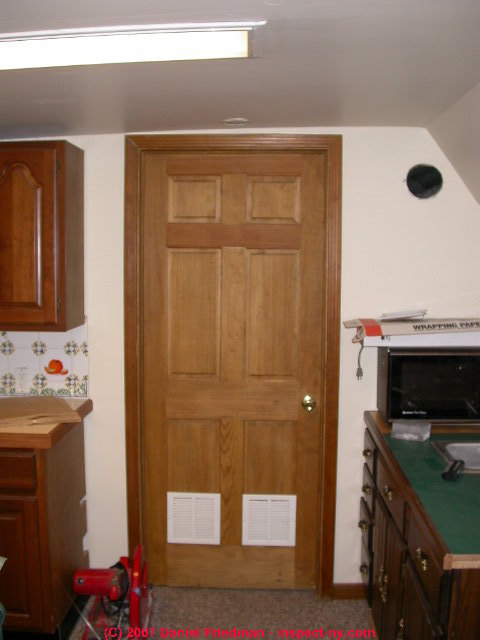
The photograph above shows a basement door into which an installer cut two return air inlets to feed basement air back to an air return located at the basement air handler.
As we discussed at RETURN AIR, INCREASE, this is a poor design that increases heating or cooling system operating costs. In addition to that issue, placement of return air inlets in basements, depending on their location, risk other potential hazards including CO hazards.
Carbon monoxide hazards: Return air registers too close to oil or gas fired equipment may draw combustion gases or carbon monoxide into the air duct system, sending dangerous gases into the living space
Carbon monoxide production may be increased and heating fuel combustion incomplete at nearby heaters, water heaters, or even gas clothes dryers, if
the air handler is pulling return air from a confined space where combustion equipment is also located.
Air-starved equipment may not
only work improperly, but may be unsafe, producing dangerous carbon monoxide. We've also found this problem in basements where the
owner, attempting to improve basement air quality, ran powerful exhaust fans continuously.
Watch out: you should not normally detect persistent CO in indoor air. Carbon monoxide gas indoors is odorless and colorless and can be fatal. Be sure your building has properly installed and working CO detectors and smoke detectors.
Placement of Heating or Cooling Air Returns at Outside Walls
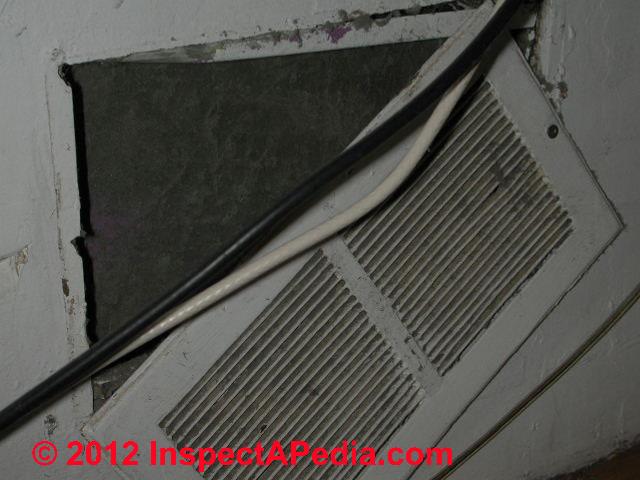
Heating or cooling return air duct systems which place the return register at outside building walls may perform poorly.
Some heating authorities opine that more effective and economical design places these registers on the interior walls - the outside walls and perimeter of some rooms may be chilly even when the heat is operating.
Other Bad Locations for Air Registers
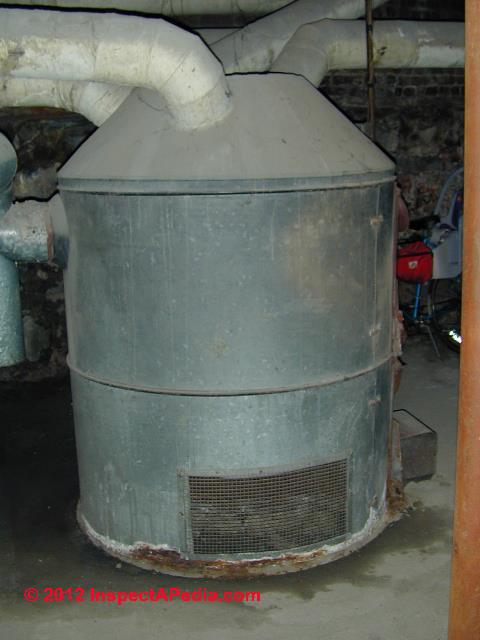
Our photo above shows an octopus furnace located in the basement of a pre-1900 home. All of the return air to this system is drawn from the un-heated basement floor - a "one-way" air movement heating design that increases heating costs as well as risking pick-up of dust, debris, or anything else undesirable from the basement area.
At UNSAFE DUCT OPENINGS we describe other air register location mistakes that can be dangerous, such as cutting a return air opening near heating equipment or in hazardous areas like a wet moldy crawl space.
...
Reader Comments, Questions & Answers About The Article Above
Below you will find questions and answers previously posted on this page at its page bottom reader comment box.
Reader Q&A - also see RECOMMENDED ARTICLES & FAQs
Where to put the return air inlet - top of the stairs?
I have two levels in my home, each 1700 sf. It has been suggested to me that I can put a large air return for the ground floor level at the top of the staircase (ceiling) that goes from the ground level to the first level. On 2020-12-27 by Isaac
Reply by (mod) -
Isaac
Where you live and whether or not your duct system is used for both heating and cooling is pertinent in answering your excellent question about reutrn air inlet location.
If you are asking whether or not the of of a stairway is a good location for an air return duct opening, my view is yes it is, particularly for air handling system when it is in cooling mode.
That's because warm air rises in buildings; locating an air return where warm air naturally rises (up the stairwell) .
Thank you for asking a helpful question. Don't hesitate to ask further if needed.
Will a ceiling fan will interfere with A/C return air?
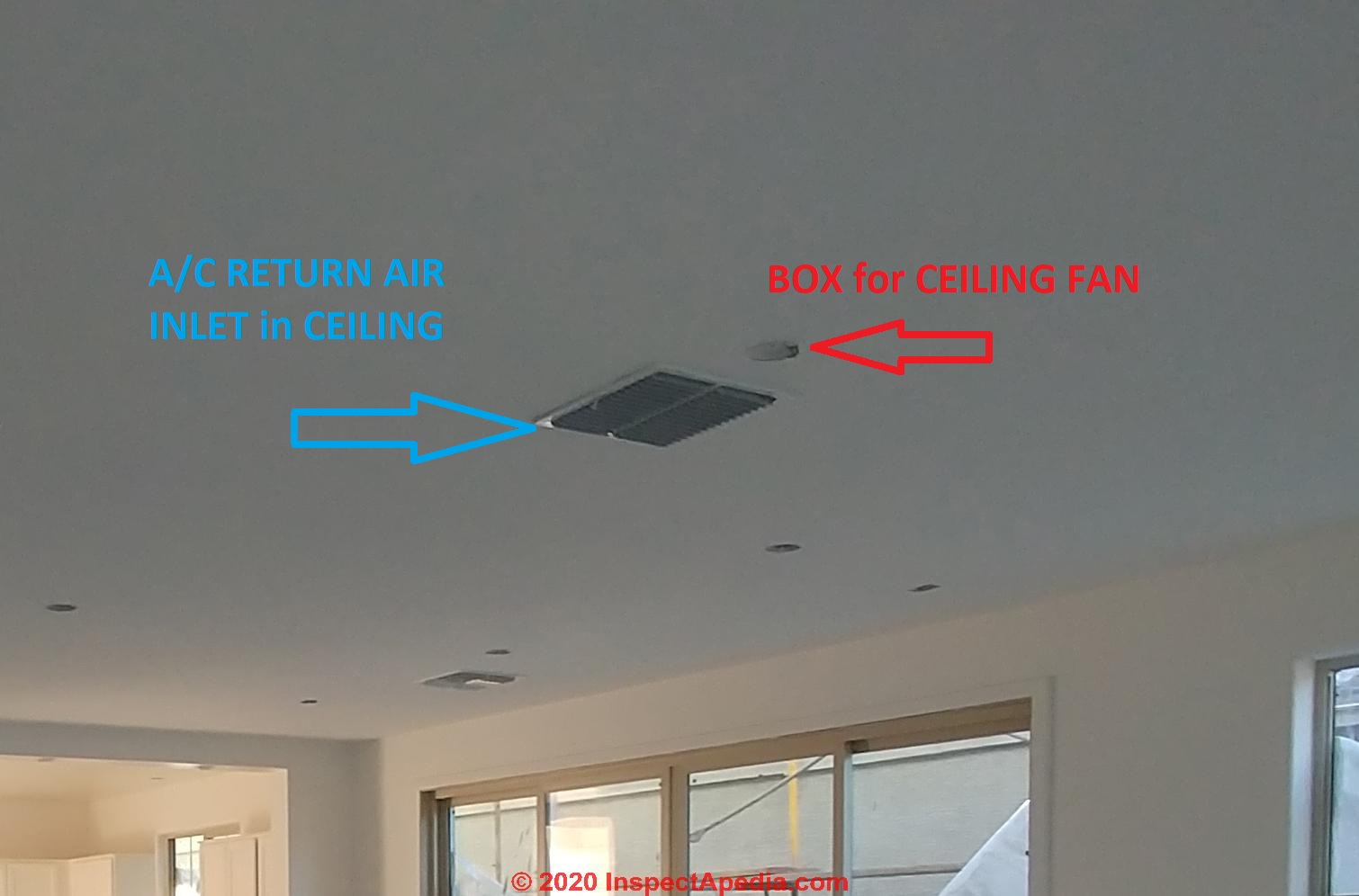 What is the minimum clearance between an electrical box in the ceiling (for a ceiling fan) and an HVAC supply register? I saw this in my newly built house and
What is the minimum clearance between an electrical box in the ceiling (for a ceiling fan) and an HVAC supply register? I saw this in my newly built house and
I don't think this is right (picture attached). Is this up to code in AZ? or at least a smart thing to do? The electrical box is in the center of the living room.
The vent is not a 4-way vent and will be blowing directly at the fan. My assumption is that the ceiling fan will eventually fail or wobble after a few cycles of getting direct cold air and heat. On 2020-08-27 by John
Answer by (mod) -
John
I haven't found a AZ building code that explicitly mentions distance from supply register to electrical boxand I don't think that causing a fan wobble is at all the issue here.
Rather the issue is interference with air movement between the future ceiling fan and the supply air register. If the ceiling fan is pushing air DOWN it will reduce air flow into the returnn air inlet (which I suspect is rather small and so marginal in the first place for a home in increasingly-hot Arizona).
Looks iffy to me, too. It's an air movement issue;
Whether or not the fan wobbles is principally dependent on:
1. Use of proper type of ceiling fan mounting box
2. Properly securing the ceiling fan mounting electrical box to building ceiling framing
3. Balancing the fan blades.
Contractor put return air duct in a closet!
In trying to improve air flow, the contractor placed a return air duct in a closet. This seems counter-intuitive to me. Is this very efficient?
Sorry I meant in ceiling above interior walls
@Mike Kegg,
My HVAC contractors put ceiling supply registers upstairs on interior walls, not above windows like I’ve always seen in the past. Is this a correct placement? This is new construction. On 2019-12-26 by Cindi
by (mod) - Duct run through a closet is OK; air inlet or supply register is NOT OK
It's ok to run ductwork through a closet, but if the air return inlet itself is in the closet in my view that is totally crazy. What: are you supposed to keep the closet door open all the time? Or maybe install a louvered closet door?
Questionable re-use of old ductwork in new building
Commercial contractor moving old hvac/ductwork to my new warehouse location. Had to add about 35ft of duct to existing. 30ft
There are 7 vents in first 30 feet (old duct) but he only has 2 in the rest of the new 35ft. Looks totally messed up.
Where should the registers be in this configuration.
Cant imagine Im getting any heating or cooling at the end of the run and thats were I need to make sure I have some.
IMAGE LOST by older version of Clark Van Oyen’s useful Comments code - now fixed. Please re-post the image if you can. Sorry. Mod. On 2018-01-07 by EdG
Reply by (mod) -
Ed
I can only guess that you want heat distributed evenly in the warehouse and that there are no local heat obstructions that would require an un-even distribution of supply registers.
It might be that you need to close some of the vents in the first 30 ft. and you may still need to add some outlets in the 2nd 35 ft.
Making even some rough subjective measures of air flow at the various supply outlets will let you balance the air flow.
Our basement is too cold in winter - no air return there
Basement is very cold winter no return in basement On 2016-07-22 by Chodak
Suggestions by (mod) -
Chodak
Sounds as if you need your HVAC company to inspect the home, evaluate the HVAC system, be sure that its airflow is operating normally - no dirty blower fan, blocked ducts, etc.When that's done, a review of both supply and return duct location and openings can tell you where to add supply or return or both.
As long as your heating system has sufficient BTUh capacity and fan capacity it'll be only a question of cost for correcting the duct system.
But watch out: do NOT take return air from anywhere too close to a fuel -burning device. Doing so is unsafe.
Can we move the air register in our ceiling?
Can air filter register in ceiling be moved? On 2016-07-13 by beverly feldman
Answer by (mod) - yes but costly and other considerations
Yes of course; it's a matter of time, trouble, cost, impact on cooling system efficacy.
One of our air returns pulls air from the wrong area
We have a 2 story house with 2 systems in place. The House has an opened ceiling format for the living room, so all the bedrooms(4) upstairs are supplied air from the attic system.
But, one of the returns is on the upper wall of this system, so it's pulling air from one unit's area to the other's. The master bedroom has a return, but the smaller bedrooms don't. Do we need to move that return vent to one of the bedrooms? On 2015-07-10 by David Q
Answer by (mod) -
You are describing a cross-connection between return air ducts, between two different air handlers. I'm a bit confused and may not have it right.
If the areas you are trying to cool are comfortable I would not consider the expense of moving a return air duct.
Will ceiling returns be adequate for house heating?
I'm having my house rebuilt, I have 800 sq ft on first floor (using 3 ton unit) and 1200 sq ft on second floor(using 4 ton unit). They are only putting returns in my ceiling and none closer to the floor, my concern is more about heat and not so much AC...Will those returns in the ceiling heat my house? Doesn't heat rise?
My contractor states because of how the supports for the second floor were installed it is extremely difficult to rn duct work down to the floor and that just the returns in the ceiling and oversized units will be sufficient to cool and heat the house. Any opinions? Thanks. (Aug 8, 2014) Dave
Reply:
Yes Dave, warm air rises, cool air falls.
If your design priority is for heating, not cooling, you might prefer to place return registers either in floors or in walls close to floor level. You don't have to take the register all the way to the floor to make this improvement, just close to floor level.
I can't comment about the overall adequacy of the heating system or cooling system designs, lacking adequate information and possibly expertise. You'll want to have advice from an HVAC designer, engineer, or a similar expert.
So where should air supply and return registers be located?
(Jan 4, 2015) Anonymous said:
this page shows where NOT to place registers. Where do you discuss correct or best placement?
Reply:
Thanks Anon - good point. I'll work on the article above to add some "DO's". I suppose I avoided those details for a couple of reasons: many locations are OK except the DONT's we listed, but still where to place an air supply or return register for best operation varies by whether we are most interested in heating (place those registers low on a wall and in an unblocked location) or in cooling (those registers are optimally placed high on walls or in ceilings).
In many buildings there are reasons that the installer will use non-optimal locations including for duct systems that have to deliver both heated and cooled air in different seasons.
Still I'll collect and add some other suggestions.
Thanks again.
Expert says Throwing warm air claimed to avoid short-circuits in supply and return duct placement
"the air conditioning supply register is above and just a few feet from the central air conditioning return grille.
Cool air delivered to this attic room will mostly fall down to be simply drawn right back into the return."
This is a very common misconception. When properly designed, the supply air that leaves a supply air register is "thrown" in the direction that the blades on the face of the register deflects it.
Supply air registers, in residential applications, will typically "throw" the air 12-20 feet.
This said, locating the return grille on the same wall as the supply register can actually provide superior circulation, but only when the duct and register have been sized properly and matched with a supply register that deflects the air in the appropriate direction. In fact, in most more confined rooms such as bedrooms, locating the supply air outlet on the same wall as the return air inlet will provide superior circulation the majority of the time.
Imagine that you have an enclosed container that is full of water. On one side of the container, you cut a hole and mount the end of a garden hose to it. Right next to that hole you install a drain that is negatively pressurized "sucking".
When you turn the water on, the water is thrown horizontally towards the opposite side of the container.
That water will not return make the 180 degree change in direction until one of two things happens. The jet of water looses all of it's speed (velocity) or the jet of water is redirected as a result of hitting the opposite side of the container or some other obstacle.
Remember that a specific amount of water is being thrown in a specific direction and the drain is sucking that same amount of water from any and all directions.
In addition, the jet of supply air actually increases in volume as it travels across the room as a result of the venturi effect. So not only does it not short cycle back into the return air inlet, it actually picks up additional adjacent air and moves it away from the return air. On 2013-01-15 by David C Brown at www loadcalcula -
by (mod) - comments on HVAC short-circuiting
Thank you for the welcome discussion, and for your HVAC short circuiting opinion, David.
I agree that coming out of a supply register the air velocity and the direction of the vanes on the register are factors that direct air into the room
I don't agree that placing supply and return ducts together is a good practice nor can we support a postulate that short circuiting doesn't occcur when supply and return ducts are too close or poorly-located.After all, there is velocity and "suction" at the return inlet just below that "throwing" movement of warm air at the supply register. When they're close together anybody with a smoke tester can almost always see a dramatic turn in the out-flowing warm air from the supply if there is a return too close by.
Key in your statement is "when properly-designed" - in our field experience we see plenty of HVAC supply and return registers that were not "designed" at all.
Common heating and cooling air supply-return register snafus by the installer include
- Supply and return short circuits as we've described on this page
- Under-sized return so that the air handler is starved for return air - this is perhaps the most common snarl-up we see in new construction
- Returns located so as to kill building occupants by figting the gas burner for combustion air, producing fatal carbon monoxide
- Systems that draw all of their supply air from a cold basement or crawl space: a "one-way" heating system that is as expensive to operate as possible
- and a host of other duct dilemmas encountered by inspectors and technicians in the field.
I welcome your further argument in this matter, David. Working together makes us smarter.
On 2013-03-01 by Matt
@David - that's what I was thinking. As long as the fan blades push the air out from the top vent, then a circular cycle of air should result as it spews out and is sucked back in towards the air intake below.
I was just wondering though, would it be much better for an air conditioned to have the air intake at the top and the air intake at the bottom? Hot air rises so this seems to make more sense to me? I live in Australia so I would very rarely ever be concerned with heating.On 2013-03-27 by Anonymous
@ Matt - No. Too much emphasis is put on whether or not the return air inlet should be located up high or low on a wall and not nearly enough emphasis on properly sizing that return air inlet. Think about it this way.
One properly sized return inlet in a hall can return the air back to the unit for multiple rooms (such as a family room, hall, dining room, kitchen, foyer...).
These rooms could be 50' away (laterally) from the return air inlet and yet the occupants comfort isn't compromised and so locating the return air inlet 6' higher or lower on a wall isn't going to make any measurable difference.
In general, A/C works better if delivered from high on walls - because cool air falls; when we supply it from the floor or low on walls the system is fighting gravity and will be less efficient.
But I agree in part with Anonymous that other factors such as return location, undercut doors, building layout, significantly affect airflow. For example, if return air is undersized or poorly located the ill effects of that will probably overshadow a supply register that is too low.
Thank you to our readers for their generous comments
On 2012-05-09 by HR
Thank you for a great resource of information. =)
Basement door air gap - Can I block it? Two story house with two cold air returns on inside wall on each floor stocked over the same spot in the house and lead directly down to the A/C-Furnace (located center of the house).
There are no vents near any of the air returns. There is a noticeable air flow under the door leading to the basement during winter and summer. With four air returns already working, do I need to keep the door to the basement unobstructed or can I close the air gap safely?
...
...
Continue reading at AIR FLOW IMPROVEMENT, HVAC or select a topic from the closely-related articles below, or see the complete ARTICLE INDEX.
Or see these
Recommended Articles
- RETURN AIR REGISTERS & DUCTS
- SUPPLY DUCTS & REGISTERS
- DUCT SYSTEM DESIGN SIZE & DEFECTS - home
- WARM AIR STRATIFICATION INDOORS
Suggested citation for this web page
LOCATION OF REGISTERS & DUCT at InspectApedia.com - online encyclopedia of building & environmental inspection, testing, diagnosis, repair, & problem prevention advice.
Or see this
INDEX to RELATED ARTICLES: ARTICLE INDEX to HVAC DUCT SYSTEMS
Or use the SEARCH BOX found below to Ask a Question or Search InspectApedia
Ask a Question or Search InspectApedia
Try the search box just below, or if you prefer, post a question or comment in the Comments box below and we will respond promptly.
Search the InspectApedia website
Note: appearance of your Comment below may be delayed: if your comment contains an image, photograph, web link, or text that looks to the software as if it might be a web link, your posting will appear after it has been approved by a moderator. Apologies for the delay.
Only one image can be added per comment but you can post as many comments, and therefore images, as you like.
You will not receive a notification when a response to your question has been posted.
Please bookmark this page to make it easy for you to check back for our response.
IF above you see "Comment Form is loading comments..." then COMMENT BOX - countable.ca / bawkbox.com IS NOT WORKING.
In any case you are welcome to send an email directly to us at InspectApedia.com at editor@inspectApedia.com
We'll reply to you directly. Please help us help you by noting, in your email, the URL of the InspectApedia page where you wanted to comment.
Citations & References
In addition to any citations in the article above, a full list is available on request.
- Prozuments, Aleksejs, and Anatolijs Borodinecs DRSC ING. "Indoor Air Stratification in Warm Air Supply Systems." ASHRAE Journal 59, no. 11 (2017): 54-65.
- Thanks to Mark Cramer, Tampa Florida, for assistance in technical review of the "Critical Defects" section and for the photograph of the deteriorating gray Owens Corning flex duct in a hot attic. Mr. Cramer is a Florida home inspector and home inspection educator.
- Owens Corning Duct Solutions - www.owenscorning.com/ductsolutions/ - provides current HVAC ductwork and duct insulating product descriptions and a dealer locator. Owens Corning Insulating Systems, LLC, One Owens Corning Parkway, Toledo, OH 43659 1-800-GET-PINK™
- "Flexible Duct Media Fiberglas™ Insulation, Product Data Sheet", Owens Corning - see owenscorning.com/quietzone/pdfs/QZFlexible_DataSheet.pdf
"Owens Corning Flexible Duct Media Insulation is a lightweight, flexible, resilient thermal and acoustical insulation made of inorganic glass fibers bonded with a thermosetting resin." - Our recommended books about building & mechanical systems design, inspection, problem diagnosis, and repair, and about indoor environment and IAQ testing, diagnosis, and cleanup are at the InspectAPedia Bookstore. Also see our Book Reviews - InspectAPedia.
- Complete List of Air Conditioning & Heat Pump Design, Inspection, Repair Books at the InspectAPedia Bookstore.
- In addition to citations & references found in this article, see the research citations given at the end of the related articles found at our suggested
CONTINUE READING or RECOMMENDED ARTICLES.
- Carson, Dunlop & Associates Ltd., 120 Carlton Street Suite 407, Toronto ON M5A 4K2. Tel: (416) 964-9415 1-800-268-7070 Email: info@carsondunlop.com. Alan Carson is a past president of ASHI, the American Society of Home Inspectors.
Thanks to Alan Carson and Bob Dunlop, for permission for InspectAPedia to use text excerpts from The HOME REFERENCE BOOK - the Encyclopedia of Homes and to use illustrations from The ILLUSTRATED HOME .
Carson Dunlop Associates provides extensive home inspection education and report writing material. In gratitude we provide links to tsome Carson Dunlop Associates products and services.

